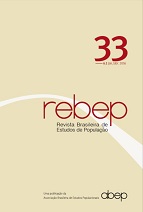Quality of information on fertility in the 2010 Population Census in Brazil
DOI:
https://doi.org/10.20947/S0102-309820160010Keywords:
Qualidade da informação, Fecundidade, Métodos indiretos, BrasilAbstract
The purpose of this research note is to exam the quality of information on fertility in the Brazilian demographic census of 2010 and to make inferences on the accuracy of the estimates of the total fertility rate (TFR) and age-specific rates estimated with that data source. The databases used are microdata from the 2010 population census and the Births Information System (Sinasc) of 2009 and 2010. Basic demographic indicators and the Brass’ indirect method of P/F ratio to estimate TFR are used for the two data sources analyzed. The results show that census data are quite consistent, nonetheless they have problems of undercount for current fertility age-specific rates, as is well known in demography. This undercount must be taken into account when estimating the level of fertility for the country. The changes in fertility schedule affect fertility since TFR is a period rate, but the P/F Brass method still presents good results. Finally, some recommendations for possible improvements in data collection, mainly in censuses and sample survey of households are offered. These are essential data sources for estimating fertility and for
monitoring its trends and for updating projections of this indicator in the medium and long run.
DOI http://dx.doi.org/10.20947/S0102-309820160010
Downloads
Downloads
Published
How to Cite
Issue
Section
License
Papers published in Rebep are original and protected under the Creative Commons attribution-type license (CC-BY). This license allows you to reuse publications in whole or in part for any purpose, free of charge, even for commercial purposes. Any person or institution can copy, distribute or reuse the content, as long as the author and the original source are properly mentioned.

